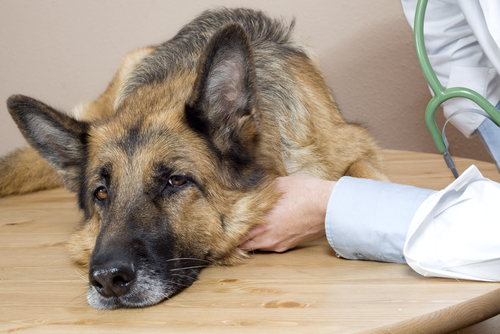Obsessive Compulsive Disorder (OCD) in humans is characterized by repetitive thoughts and behaviors that cause stress. The thoughts are the obsessions and the behaviors are the compulsions. The thoughts are often unreasonable and the compulsions interfere with one’s normal life.
The cause for people is believed to be multi-factorial and new advances are being made. Because dogs’ thoughts are difficult to define, the canine version of this disorder is simply referred to as Canine Compulsive Disorder (CCD). CCD has been touted to be a good human model for OCD. Multiple studies have found parallels in brain structure and even identified specific gene analogues when comparing affected humans and canines.

One example of a studied disorder is a phenomenon called flank sucking, specific to Doberman Pinschers, in which the dog will repeatedly suck on an area of his body (usually, but not always the flank) to the point of life interference. Like the human compulsions, this activity is thought to be a method of self-soothing. Sometimes these behaviors are referred to as stereotypical because they are repetitive and serve no obvious purpose.
Another example is repetitive circling in Belgian Malinois dogs and a third is tail chasing, in other breeds, including German Shepherd and Bull Terrier. The stereotypical behaviors are defined as abnormal because they seem to lack a survival purpose, are frequent, repetitive and can impact the quality of life in a negative way.
MRI and other diagnostic modalities have demonstrated actual structural differences in the brains of affected dogs that appear analogous to the structural changes in affected human brains. One study, in Dobermans even narrowed the compulsive findings down to a specific gene.

If you have noticed your dog engaging in repetitive behaviors, it is critical that you involve your veterinary team. Because our patients are nonverbal, no part of the diagnostic work up should be omitted. CCD is a diagnosis that should be made only in the absence of another medical syndrome.
It is important to recognize that there are truly cases of CCD and such pets will need medical intervention. But it is equally critical to realize that because a dog cannot be interviewed to explain his thoughts and behaviors, he could be exhibiting them for an entirely different reason. Consider that a dog is circling because of a neurologic problem and his owner decides that he suffers from CCD and that the behavior is an innocuous sign. The affected dog would then progress into whatever neurological process originally caused him to circle and he could die untreated.
Dogs can exhibit behaviors that appear stereotypical for other seemingly unrelated reasons, like pain, injury, neurological, dermatological or metabolic disease and these dogs must be examined by a veterinarian and worked up for these other issues first before a diagnosis of CCD can be made. It would be a travesty to assume a diagnosis of CCD and treat it while leaving other issues uncovered and unaddressed. Please take your dog to a vet if you notice repetitive behaviors because regardless of the cause, your dog deserves help.
